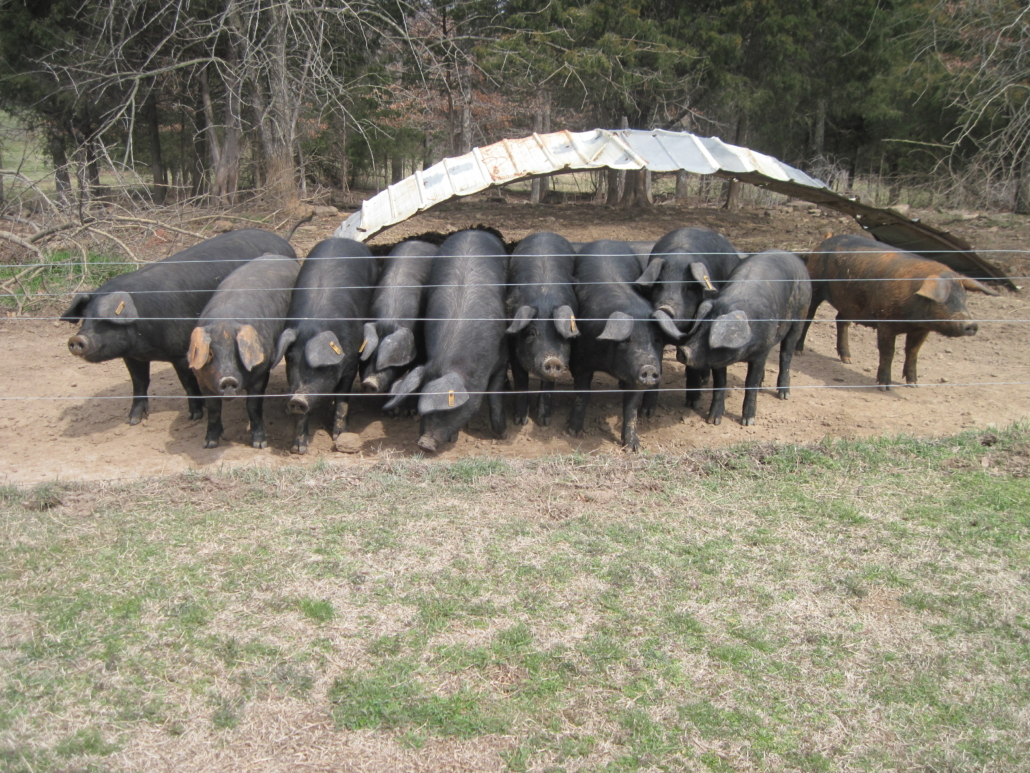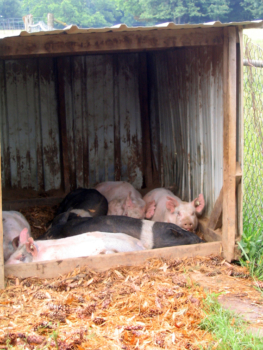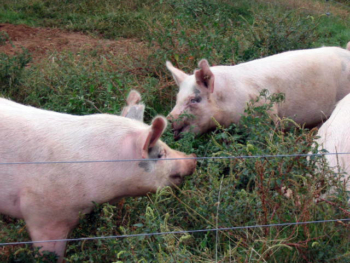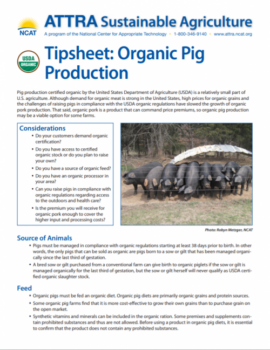Tipsheet: Organic Pig Production

Photo: Robyn Metzger, NCAT
By Margo Hale and Linda Coffey, NCAT Agriculture Specialists
Pig production certified organic by the U.S. Department of Agriculture (USDA) is a relatively small part of U.S. agriculture. Although demand for organic meat is strong in the United States, high prices for organic grains and the challenges of raising pigs in compliance with the USDA organic regulations have slowed the growth of organic pork production. That said, organic pork is a product that can command price premiums, so organic pig production may be a viable option for some farms.
Considerations
- Do your customers demand organic certification?
- Do you have access to certified organic stock or do you plan to raise your own?
- Do you have a source of organic feed?
- Do you have an organic processor in your area?
- Can you raise pigs in compliance with organic regulations regarding access to the outdoors and health care?
- Is the premium you will receive for organic pork enough to cover the higher input and processing costs?
Source of Animals
- Pigs must be managed in compliance with organic regulations starting at least 38 days prior to birth. In other words, the only pigs that can be sold as organic are pigs born to a sow or gilt that has been managed organically since the last third of gestation.
- A bred sow or gilt purchased from a conventional farm can give birth to organic piglets if the sow or gilt is managed organically for the last third of gestation, but the sow or gilt herself will never qualify as USDA certified organic slaughter stock.
Feed
- Organic pigs must be fed an organic diet. Organic pig diets are primarily organic grains and protein sources.
- Some organic pig farms find that it is more cost-effective to grow their own grains than to purchase grain on the open market.
- Synthetic vitamins and minerals can be included in the organic ration. Some premixes and supplements contain prohibited substances and thus are not allowed. Before using a product in organic pig diets, it is essential to confirm that the product does not contain any prohibited substances.
- The feeding of mammal and poultry slaughter byproducts—tallow, grease, meat and bone meal, feather meal, and spray dried plasma—is prohibited. The feeding of crystalline amino acids such as L-lysine, DL-methionine, L-threonine, and L-tryptophan is not allowed. Similarly, the feeding of exogenous phytase, subtherapeutic antibiotics, or hormones is prohibited.
- However, organic eggs, organic dairy products, and commercial fishmeal are allowed.
Health Care
- Non-genetically modified vaccines are allowed and encouraged in organic pig production.
- Injecting newborn pigs with supplemental iron to prevent anemia is allowed.
- The use of feed additives such as organic acids, probiotics, and directly fed microbials to encourage animal health is not prohibited, but not all health-promoting feed additives are approved for use in organic production.
- Artificial insemination is allowed, but administrating hormones to synchronize estrus or stimulate growth is prohibited in organic production.
- Approved parasiticides also can be used when preventive practices have proven ineffective. Use of parasiticides is restricted to breeding stock, and they must be administered prior to the last third of gestation.
- Treating lactating sows or market animals with parasiticides is required if medically necessary, but the sow, her nursing piglets, and the market animals would then lose their organic status.
- Physical alteration of organic livestock to promote their welfare is allowed but should be performed in a manner that minimizes pain and stress.
- Organic livestock must be identified, and the use of ear notches, ear tags, and tattoos are all currently approved methods for individually marking breeding stock and potential replacements.
Living Conditions
-

Photo: Luci Shepherd, NCAT
Organic pigs must have access to outdoors, shade, shelter, exercise areas, fresh air, clean drinking water, and direct sunlight as suitable for the animal’s stage of
life, the climate, and the environment. - Pigs are required to have access to the outdoors, but raising pigs on pasture is not required by organic regulations.
- Organic pigs must have access to clean and dry bedding. If the bedding is crop residue, it must be from organic crops. Other bedding materials such as shredded newsprint, wood chips, wood shavings, sawdust, and sand are allowed in organic systems and do not need to be certified organic.
- Organic regulations do not specify exactly how much living space is adequate. However, most firms that buy organic pigs and many retailers that market organic
pork have adopted more-specific space requirements.
USDA organic regulations do not directly address farrowing crates or gestation stalls, but organic livestock are required to have access to the outdoors, direct
sunlight, and the opportunity to exercise. Any production practice that restricts access to required living conditions must be discussed with the certifier ahead
of time and will need to be for a very limited period.
Some markets may have additional requirements regarding crates or stalls.
Processing
If you want to sell pork as organic, it must be processed in a certified organic processing facility.
There are different levels of processing, and access to them will affect how you can market your animals.
- Federal or USDA Inspected Plants—Federal plants can process meat for nationwide sale.
- State Inspected Plants—Only about half of the states have a State Inspection Program. State inspected plants can process any meat, but it is stamped for sale only within that state.
- Custom Exempt Plants—A custom plant processes for individual use. The meat must be stamped “not for sale.”
- Mobile Processing Unit—A truck- or trailer-mounted facility that is transported to the processing site. Some are state or federally inspected.
- On-Farm Slaughter (exempt from inspection)—Animals are processed by the owner for individual use (regulations vary by state).
Meat processing regulations are explained in more detail here.

Photo: Linda Coffey, NCAT
Further Resources
Raising Organic Pigs: A Guide to USDA Certified Organic Requirements, ATTRA
ATTRA’s Organic Farming resources
USDA Organic Regulations 7 CFR 205:
USDA National Organic Program Handbook
USDA National List of Allowed and Prohibited Substances
Tipsheet: Organic Pig Production
By Margo Hale and Linda Coffey, NCAT Agriculture Specialists
Published July 2015
IP510 Slot 523
This publication is produced by the National Center for Appropriate Technology through the ATTRA Sustainable Agriculture program, under a cooperative agreement with USDA Rural Development. This publication was also made possible in part with support from U.S. Department of Agriculture’s Agricultural Marketing Service, National Organic Program. ATTRA.NCAT.ORG.


